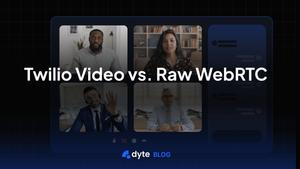In the digital age, the way we communicate has undergone a radical transformation. The advent of Web Real-Time Communication (WebRTC) technology has played a pivotal role in this evolution, enabling seamless, high-quality communication across the web. Among the frontrunners in leveraging this technology was Twilio, with its Programmable Video.
In case you don’t already know, Twilio in December 2023 decided to sunset Twilio Video, and it is scheduled to go offline by 5th December 2024. So, it’s a good idea to start looking for a Twilio Video alternative soon, in case you haven’t already found one. Feel free to check out Dyte. Here’s an in-depth comparison of Twilio Video vs. Dyte.
This guide delves into Twilio WebRTC, exploring its features, benefits, and how it's shaping the future of communication.
What is Twilio WebRTC?
Twilio WebRTC, a cloud-based platform, is founded on the open-source standard WebRTC. This framework harnesses WebRTC's core capabilities for real-time voice, video, and data communication in web browsers, enhancing it with extra functionalities.
Twilio's Programmable Video offering, slated for discontinuation starting December 2024, was based on a customized version of the Chromium WebRTC project. This approach involved adapting the open-source WebRTC code to suit the unique requirements of their platform. Though the service is no longer accessible to new users, recognizing its roots in WebRTC illuminates Twilio's approach to crafting communication solutions.
In essence, Twilio Video was a managed WebRTC. Read more about WebRTC vs. Managed WebRTC.
Before we deep dive into Twilio vs. WebRTC. Let’s first understand the key features of Twilio WebRTC.
Key Features of Twilio WebRTC
- Seamless Communication: Integrate voice, video calls, screen sharing, and data channels directly into your web applications with ease.
- Customization: Twilio WebRTC offers a high degree of customization, allowing you to tailor the communication experience to fit your specific needs.
- Recording and Transcription: Capture and store calls for later review or transcribe them into text for further analysis.
- Scalability: Twilio's global infrastructure ensures your communication needs are met, regardless of traffic spikes.
- Security: Enjoy industry-leading security features to protect your communications and user data.
Twilio vs. WebRTC
In the realm of digital communication, particularly in the development of video-based applications, two notable options stand at the forefront: utilizing a service like Twilio Video or going the route of raw WebRTC. Both avenues offer pathways to integrating real-time video communication, but they diverge significantly in terms of complexity, support, and scalability. Let’s understand the mechanics behind Twilio vs. WebRTC
Understanding Raw WebRTC
WebRTC, at its core, is an open-source project that provides web browsers and mobile applications with real-time communication capabilities via simple application programming interfaces (APIs). It's the bedrock upon which many video communication solutions are built, offering a free, basic framework for developers to create peer-to-peer video, audio, and data channels.
The appeal of raw WebRTC lies in its open-source nature and the level of control it provides. Developers have the freedom to craft a video communication tool from scratch, customizing every detail to suit their unique requirements, all without incurring costs for the WebRTC technology itself. Yet, this opportunity comes with its own set of challenges, such as the necessity for an in-depth understanding of WebRTC internals, independently managing signaling, and configuring STUN/TURN servers to address NAT/firewall obstacles when establishing peer-to-peer connections.
Twilio Video as a Managed WebRTC
Twilio Video, on the other hand, presents a more packaged solution, building on the foundation of WebRTC to offer a managed service. This includes not just the basic building blocks of video communication but also additional features and supports like scalable TURN servers, signaling, SDKs for various platforms, and analytics. These additions aim to simplify the process of integrating video communication into applications, making it accessible even to those with a more modest technical background in WebRTC.
Choosing Twilio Video entails adopting a platform that streamlines the intricate process of establishing a dependable and expandable video communication service. It provides swift integration, extensive documentation, and personalized assistance. Nonetheless, these advantages are not free; they come with costs, both in terms of service fees and figuratively, as they entail relinquishing some control over implementation specifics compared to a raw WebRTC method.
Choosing Between Twilio vs. WebRTC
The decision between Twilio Video and WebRTC depends on the specific requirements of the project. If a straightforward, browser-based real-time communication solution is sought, WebRTC may suffice. However, Twilio Video emerges as a compelling choice for those looking to expedite development, enhance scalability, and leverage additional features.
- Development Complexity: WebRTC may be more suitable for projects with straightforward requirements, while Twilio Video is advantageous for those seeking a streamlined development process.
- Scalability Needs: If scalability is a primary concern, Twilio Video's built-in features can simplify the management of larger user bases.
- Platform Diversity: For applications targeting multiple platforms, Twilio Video's cross-platform compatibility becomes a valuable asset.
| Feature | Twilio Video | Raw WebRTC |
| Ease of Use | Pre-built SDKs, simpler development | Requires development expertise |
| Scalability | Managed infrastructure, handles high volume | Requires building and managing own infrastructure |
| Security | Built-in security features | Requires custom security implementation |
| Cost | Pay-as-you-go pricing | Free, but additional costs for development and infrastructure |
| Features | Includes recording, transcription, virtual backgrounds | Core WebRTC functionality only; additional features require custom development |
| Ideal For | Businesses lacking development resources, seeking fast implementation | Businesses with development expertise, requiring extensive customization |
Common Issues with Twilio Video and WebRTC
Twilio Video and WebRTC are powerful technologies that enable developers to integrate real-time video communication into their applications. However, users may encounter several common issues during implementation and deployment. Understanding these issues can help in troubleshooting and ensuring smoother operation.
- Connectivity and Network-Related Issues: Connecting applications with Twilio Video and WebRTC can encounter a common hurdle - navigating connectivity issues. These hurdles typically stem from firewalls limiting UDP traffic on specific ports or non-BEHAVE-compliant NATs, complicating direct connections (Twilio Documentation). A key step in ensuring stable video and audio streams is configuring your network infrastructure to permit essential traffic.
- Audio and Video Quality Degradation: Another common issue is the degradation of audio and video quality during calls, which can result from a variety of factors, including poor network conditions. Twilio Video, built on top of WebRTC, is designed to adapt to changing network conditions to maintain call quality. However, reaching the minimum video quality threshold can sometimes be challenging in environments with significant bandwidth constraints or fluctuating internet speeds (Source).
- Device Compatibility and Configuration: Ensuring device compatibility and configuration presents challenges, particularly in diverse client environments. Problems may span from misconfigured audio/video input/output devices to hardware or OS incompatibilities. Developers might usually have to handle this efficient error handling, user interface adjustment, or utilizing Adapter.js to account for these.
Where does Dyte stand?
Dyte being a managed WebRTC, leverages the strengths of raw WebRTC and handles WebRTC limitations in an elegant and efficient manner. Dyte stabilized WebRTC hiccups and overcomes complex customizations, scalability, call drops, etc. Check out how Dyte compares to the raw WebRTC.
Now, coming to Twilio Video, Dyte has complete feature parity and more with interactive plugins, UI Kit, advanced analytics, etc. Here’s an honest comparison between Twilio Video and Dyte, feel free to checkout the benchmarking report and see for yourself that Dyte is more than just a Twilio Video replacement.
Twilio Video Enterprise users are also eligible to receive credits up to $30,000. Learn more



